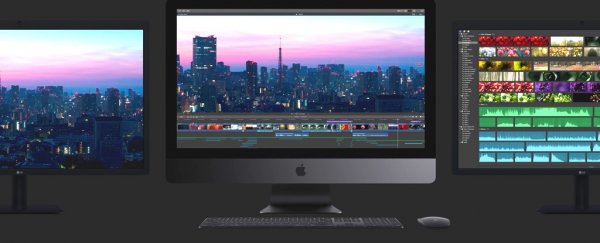Leaked documentation reveals new Macs contain a hidden mechanism designed to make them inoperative if they are independently repaired, reports show.
According to technical memos obtained by a number of outlets, any Mac with Apple's new T2 chip conceals a security feature critics describe as a 'kill switch', which effectively bricks the devices if they receive 'unauthorised' repairs.
Right now, the only computers on the market with the T2 chip inside are the iMac Pro and MacBook Pro (2018) models, although it's possible the component will be rolled out to other devices when Apple updates its product lines.
What the kill switch does, in theory, is ensure that nobody other than Apple or Apple Authorised Service Providers (AASPs) can repair a number of the primary functional components of the T2-equipped iMac Pro and MacBook Pro.
If any unauthorised tampering takes place, the kill switch is activated, which "will result in an inoperative system and an incomplete repair", per the wording of Apple's internal documentation.
This lock-out process is designed to kick in if you tamper with the MacBook Pro's display, logic board, Touch ID sensor, or the top of the case (housing the keyboard, battery, trackpad, and speakers), as MacRumors explains. In terms of the iMac Pro, the logic board and flash storage are the no-go areas.
The only way to get around this, according to the tech memo, is to use Apple's proprietary system diagnostics software as part of the repair process. The thing is, the specific configuration tool required – called Apple Service Toolkit 2 – is only available to Apple staff and authorised AASP repairers.
Because of this, if you want to fix or upgrade your Mac, the kill switch effectively prevents you from attempting to do the job yourself, or visiting any independent (unauthorised) third-party repair shops.
Or does it?
Since MacRumors and other sites disclosed the kill switch last week, at least one intentional attempt to trigger the security trap resulted in… nothing.
To test the feature, technical gurus and right-to-repair advocates iFixit purchased a brand-new 13-inch MacBook Pro with Touch Bar, and promptly disassembled it, swapping out its display and logic board, to see what would happen.
To their surprise, the computer behaved perfectly normally despite the tampering, and didn't become inoperative like Apple's internal docs suggest it should have.
"That's a promising sign, and it means the sky isn't quite falling – yet," iFixit's Adam O'Camb explains in a blog post.
"But as we've learned, nothing is certain… It's very possible that a future software update could render these 'incomplete repairs' inoperative, and who knows when, or if, a fix will follow."
Nonetheless, given the device didn't fail after the unauthorised repair work, iFixit concludes the kill switch feature outlined in Apple's internal memos must not be activated – yet – even though it looks to be a real thing, given where the leak came from.
Just when it will become operational is anybody's guess, but the mere existence of anti-repair (and anti-consumer) features like this is a thorn in the side of those campaigning for the right to repair products like personal electronics and automobiles.
Apple has a history of fighting efforts to get this right legally recognised in the US, which makes it harder for people to get their devices fixed, especially if they live in regions that can't access authorised providers.
"This is a continued campaign of obsolescence and they want to control the ecosystem and bring all repair into the network they control," iFixit CEO Kyle Wiens told Motherboard.
"It could be really detrimental to schools, to people who live in rural areas. If they stick with this, it seems like a huge argument in favour of right to repair."
